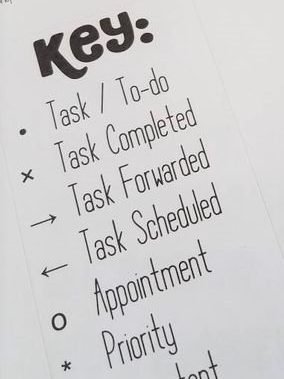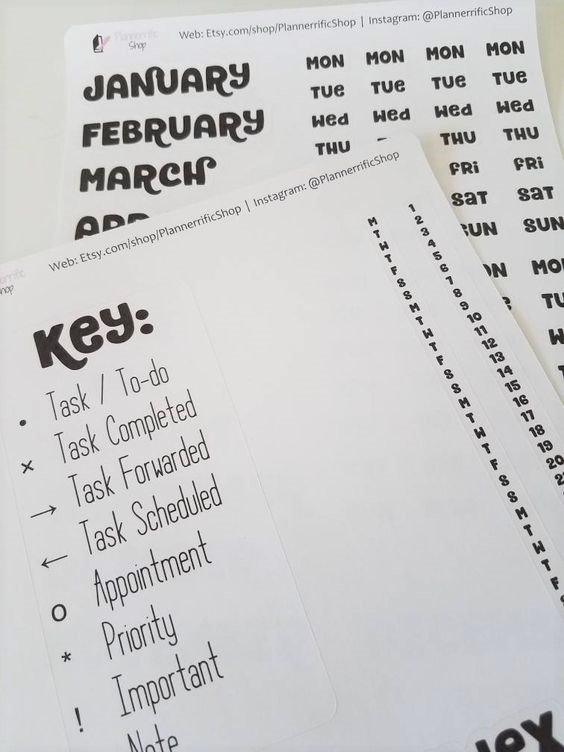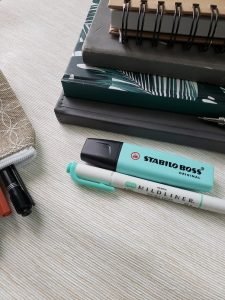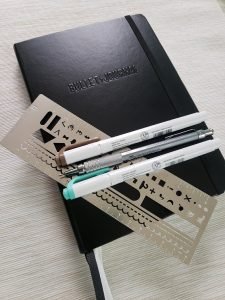When you first learn about the Bullet Journal, you inevitably come across the term ‘key’. Bullet Journal uses the key as an important part of its system. Lets learn about what the key is and how it is used.
What is the Bullet Journal key? The Key is a set of symbols and signifiers that the Bullet Journal system uses to denote and mark up the tasks, events, notes, appointments and anything else that needs to be identified with ease. These shortcodes serve as bullets in the list of items and hence the system is called a Bullet Journal.
Even though there is a classic key that was introduced together with BuJo (short for Bullet Journal), people tend to customize the key over time to serve their needs. Let’s dive in to see how the key works and how you can put it to use in your journal.
What is a Bullet Journal Key
The key is a set of various symbols, each of which supposed to represent a specific type of item in your journal’s list.
Designed as a part of a Rapid Logging style of note-taking, key can be thought of as short code that is you in the court notes. The goal of the Rapid Logging is to jot down your lists, thoughts, to-do as quickly and as sufficiently as possible.
By assigning each type of item you write in your journal, you can, at a glance tell what’s going on in day just based on the symbols.
The symbols that are used in the key can be any single character item. It can be anything from a dot to dash to x to exclamation point to *, and so on as long as they mean one thing and with consistency.
For example, you can decide that every time you put a $ at the beginning of your list item, that means you need to pay bills. So, when you glance at your to-do list in the morning and you spot the $, you will know that it’s time to part with your cash.
You can choose the * to stand for laundry or # to represent bookkeeping for your business.
By using same symbols consistently with same type of items, you will speed up the time of your note-taking and have a full picture of what’s on your place without reading into each individual item.

Where does the list of keys go in the Bullet Journal
The list of keys or the ‘Key’ usually goes in a very beginning of a journal, to set the system right from the start and make it easier for you to locate it for reference.
However, this is not a hard rule, nothing in BuJo is. If you decided to convert your existing journal into a Bullet Journal half-way down, you can just go the next available page and make it your Key.
Another place to have the key is to have a fold out half-page attached to the front or the back cover of the journal to make it even more accessible.
You can also use one of those wide carton bookmarks they sell in the book store, cover it in paper, write up your key on it and make it serve two functions: a key and a place-holder in your journal.
Ryder Carroll’s Bullet Journal and use of keys
Ryder Carroll who created the Bullet Journal system, shares his key that he developed through the years and that serves him well still.
It’s a short list, very clean and minimal and a perfect place to start when you just begin using the system.
Ryder’s key symbols are as follows:
• A bullet dot – New Task that needs to be done
× An x bullet – a Task that has been Completed
> Right-pointing arrow –a Task that has been Moved (migrated) to the Following day (forward)
< Left-pointing arrow –represents a Task that has been Moved further out into the Future. It points left because we are moving the items into the Future Log which is a list at the beginning of the journal and so you would page your journal back to locate it
O An empty circle – represents an Event
– A dash – used for Notes
Cancelled – A strike-through denote a task that has been cancelled or irrelevant

Each classic Bullet Journal key in action
Now that you know the classic key symbols, let’s see how you would use them.
Let’s say you need to buy the groceries, attend a birthday party, you had to pick up the dry-clean (and you already did it), you have to move an oil change to tomorrow and reschedule the bookkeeper to next month. Oh, you also thought to do the highlights but you changed your mind and made a note about it.
Here is how these items would look in your Bullet Journal:
• Buy groceries
O Emma’s b-day party
X Pick up dry-clean
> Oil change
< Bookkeeper
Try highlights
– I love my hair
Every day will look different.
Some days you might have nothing but tasks and some days all the tasks will have to be moved to next day.
Some days will be quiet with just notes highlighting your day.
Other days will be mix and match like the example above.
What are Bullet Journal signifiers
In addition to key symbols, you might come across the ‘signifiers’.
Signifiers in the key are enhancers to the key bullets. They add an extra significance to the items you already have on the list. They are placed in front of the key symbol to call your attention to that item first.
The classic signifiers that are used in the original Bullet Journal are ! and *.
* is for priority items and ! is for items that are inspirational.
What does each signifier mean
* is used to show a Priority of that item. So if you have five • items on your list, but one if them is really important, you would note it with both * and • like this:
*• Pick up asthma medicine
! is used to she something inspirational. You often see it along with the note symbol (-). So, if you made a note about a trail you found and it was incredible, your item will look like:
! – Willow trail today was amazing
How to start using the keys and signifiers
Now that you have an idea what key symbols and signifiers are, you can start using them in your Bullet Journal note taking.
Start with the task identifier.
Since we all have to-do’s almost every day, the task identifier (•) is the one you can put to use right away. Just place that bullet dot in the beginning of the line when you write out your list, like this:
• Pay rent
• Call the plumber
• Make a dentist appointment
As you complete the items, put an X through that dot:
X Pay rent
At the end of the day, if the items are not completed, move them to the following day and place the > in front of the item like this:
> Call the plumber
If throughout your day you have an idea or an observation, make a note, like this:
– Maybe I can ask my dad to fix the leak?
How to make the keys and signifiers of your own
The key symbols and signifiers you saw above are what started the Bullet Journal and they are great when you just starting up. And, by all means, you can continue using them and only them forever, but you don’t have to.
Ryder Carroll always talks about how Bullet Journal is flexible and should work for You.
So, if you find that the classic key is not working for you, you can add, change, take away the symbols and replace them with what works for you.
For example, for me ! is clearly a sign of importance, attention, almost emergency. So, in my list, I use ! (instead of classic *) to denote priority.
I also love making nested lists, especially when I take notes for class or if I’m thinking through a project and so I use -> for subtasks that go under the main task (•).

You can customize the key with symbols that work for you. You can choose a triangle to signify the events and # to represent the appointments.
Your bullet key symbols will differ depending what you are using your bullet journal for. If you are all about school you might have different symbols than if you are all about dieting and meal planning.
Give a thought to the symbols you already use in your life in your notes or scribbles and think of what they mean to you. If you find things you use all the time, consider incorporating them into your own personalized Bullet Journal key.
Drawing your own key page
Once you decide on what your keys are, you can draw them up on a key page in your Bullet Journal.
It can be in a very beginning of your journal if you are starting anew, or on the next free page if you are using one of your half-used notebooks.
Just go to the page of your choice, write the word ‘KEY’ at the top (the letter style, size and color is up to you).
Then, underneath, 1 per line, write out a symbol and its meaning next to it.
If you suspect that you might add key symbols in the future, you can space the lines leaving room at the bottom of that page.
Here are some great key pages I have found on Instagram:
Buying pre-designed key pages
If you are intimidated to write your own key (I know, I totally used to be!) you can purchase pre-designed key pages on Etsy and other places where digital downloads are offered.
You can also purchase them as stickers so that all you need to do is to peel and stick.
Using color coding instead of key system
If you feel like using the symbols is to dry, you can add or replace them with color-coding.
Choose a small number of colors to represent different things in your life and either write the items using those colors, or highlight the items already written.
You can decide that red is for important items, light-blue is for self-care, orange is for meals and purple is for book club meetings, it’s up to you.
Color-coding makes your journal pretty and exciting to look at.
Just make sure you don’t get carried away with too many colors or, after a while, it will be hard for you to remember what is what (and you will have to carry ALL those pens and markers!).
Why use the keys in your personal BuJo
Now, if all of this sounds like learning a new language, you might wonder – why use the key at all?
While you don’t have to use the key in your journal – after all you do what works for you – key was designed to make your note-taking faster, more organized and efficient.
Key symbols, when used consistently, create order and flow in your notes, giving you a birds eye-view on your life, even if you have only a moment to glance at the page.
It also gives your items a structure, making various things stand out rather than melting together as a blob of text.
The Bullet Journal key is a great tool to streamline and organize your notes, make you more efficient in managing your journal – and your tasks, and keeps you on a top of all the things that are happening in your life without being overwhelmed by them.




